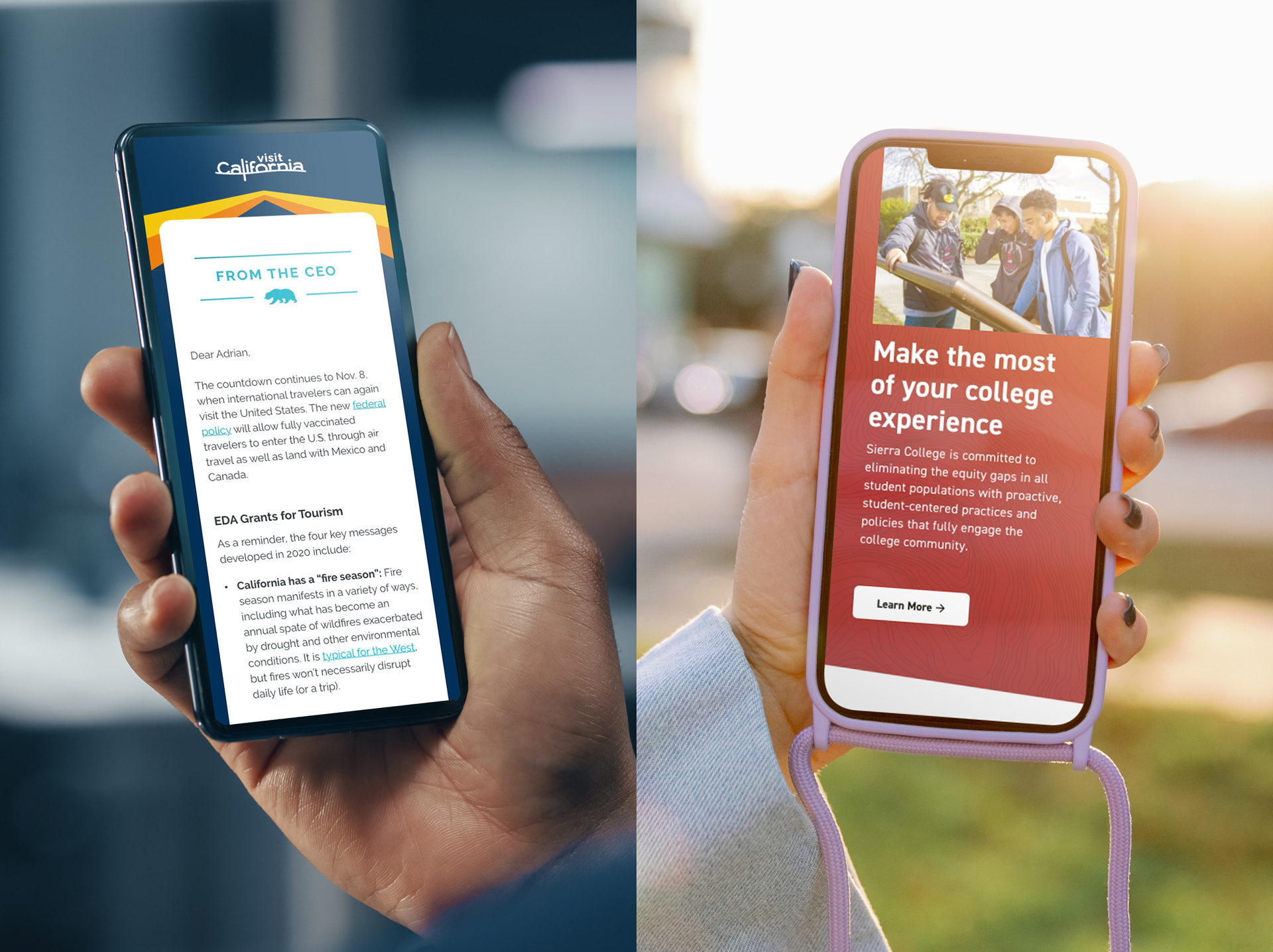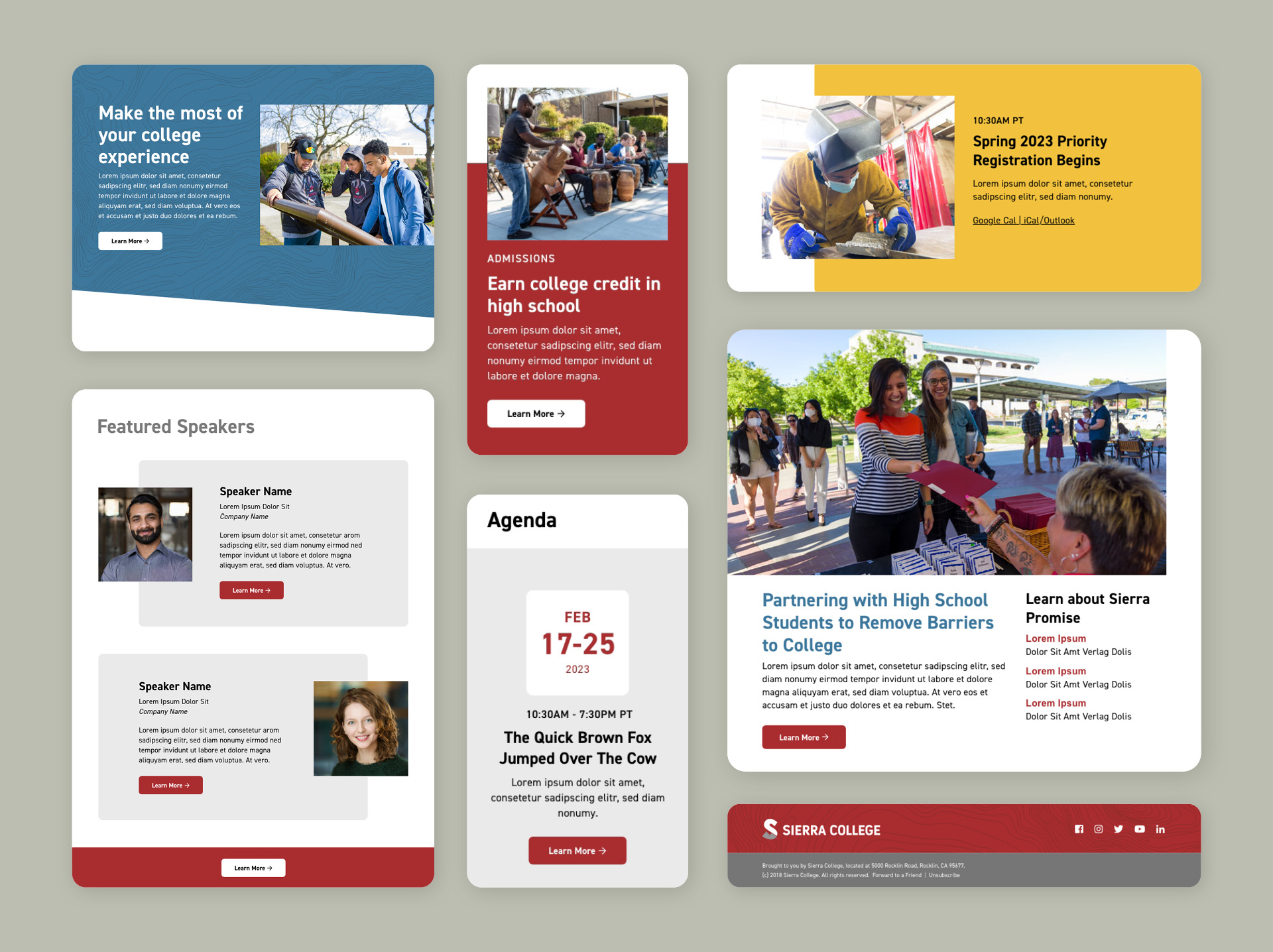6 Design and Content Best Practices to Improve Your Association’s Email Marketing
In an overcrowded media landscape, associations must build a strong connection with their members. But many of the marketing tools at your disposal have a barrier between you and your audience. Social media outreach requires time, talent, and financial investment to navigate complex algorithms. Advertising offers a potentially broad reach, but it requires considerable investment for the right exposure.
Of all the communication strategies available to you, email holds great potential because it is a direct line to your audience. In effect, members and those curious to hear more about your association have invited you in. But what does your association have to offer once you arrive?
Inboxes are competitive spaces with an array of voices vying for the audience’s attention. However, with a strategic approach to content and design, you can break through the noise and deliver a standout experience that nurtures your connection with members now and in the future.
Why Mastering Email Is Vital to Your Association’s Health
Email offers a wealth of opportunities for associations, but it can feel like walking a tightrope. Send too much clutter and your members will unsubscribe or, even worse, flag your messages as spam. Send irrelevant content, and your messages won’t be seen as useful and will become part of the noise.
You need to ensure that the content and design of the emails you send allow your audience to see the value of a direct connection with your association. Factor in the changing demographics of the workplace and the stakes grow even higher. A recent study showed 73% of millennials prefer communicating with brands through email than any other medium.
Email marketing presents a golden opportunity to nurture a connection with members. But it’s a two-way street. Your members signed up to receive messages from your organization because they want curated information from a trusted source to help them succeed.
To ensure you meet these expectations, we’ve assembled the following best practices:
1. Provide a Seamless Experience with Every Email

Much like your association’s website, every email should positively reflect and expand upon your brand story. The visual design should be consistent with your organization’s overall brand ecosystem. Your emails will include links that send readers to your website, and what they see on one should function as a fluid extension of the other. A consistent experience will enhance the perception of your brand and build a sense of trust among readers.
2. Understand Your Audience and Their Needs

Your current and prospective members give you their time and attention when they read an email. You have a responsibility to deliver on that investment and make it worthwhile.
Your organization should survey its members about the content they want to receive and consult analytics to track user behavior. That way, you develop a sense of what your audience wants and respond appropriately. Applying personalization, such as using a member’s first name from your database, will help increase email engagement and ensure your members feel valued and seen.
You should also avoid trying to serve every audience with a single newsletter. Comprehensive newsletters quickly become irrelevant if their content doesn’t resonate, and they’re often too long. Instead, create multiple audience segments and deliver customized content for each to ensure subscribers only receive relevant content.
3. Optimize Your Association’s Content for Reality

Emails should be short, scannable, and mobile-friendly. More than 46% of all emails are first opened on mobile devices. You need to ensure your designs are responsive to these screen sizes and remain lightweight so they load quickly.
You should never include the full text of a message in a newsletter unless it’s a one-off announcement or update. Instead, give your content an engaging headline with a one- or two-sentence description, followed by a button guiding readers to read more. Along with providing a digestible amount of content, you also gain analytics data on what is resonating with your audience.
4. Leverage Effective Design

Email design isn’t a one-size-fits-all endeavor. Creating templates with multiple modules optimized for different content types, such as articles, event announcements, news, etc, helps your messages stand out.
Whatever type of email you send, the content must be useful and easy to read. Design practices such as retaining an appropriate amount of white space in each message will ensure your emails appear light, airy, and inviting.
5. Use Strong Visuals Appropriately
Images enhance the storytelling in your email and engage your readers. Infographics provide engaging opportunities to express information in a persuasive, scannable way. Animated GIFs will also catch your reader’s eye, but they should be used sparingly and primarily as header images, as they can be overwhelming.
However, your email should not be one large image. Services like Gmail will identify these messages as spam and block your visuals by default. You should avoid putting text in images when possible, as images are often turned off by default in many email programs. When you can’t avoid it, be sure to add alternative text to those images — this ensures you are compliant with accessibility guidelines, and your message will still be understood if they don’t load properly.
6. Send Useful, Actionable Messages That Meet Legal Standards
Email is a powerful tool, but that power is effectively a double-edged sword. Don’t send enough, and you’ll be forgotten. Send too many, and you’ll likely annoy and eventually lose the audience you need most.
Worse yet, your IP address may be blacklisted for not complying with CAN-SPAM requirements, which is difficult to resolve and could also lead to legal action. You should always make the unsubscribe link easy to find to avoid alienating your members and being marked by readers as SPAM.
Whether inviting members to a gala, encouraging a renewal, or sharing professional resources, you should never email your members without a clear and compelling purpose. Before sending an email, ask the following question: What’s in it for your members? If you apply this simple guideline to your email marketing, you’ll nurture a lasting connection that will continue to serve your association’s goals.
Illustrations Enhance a Brand’s Story. Can They Help Your Organization?
For member-driven organizations, your brand has to tell your story and set you apart from the competition. Targeted visuals and messaging help to communicate the value of membership, and engage your audience. As you aim to connect with the next generation of members, you need to ensure that the story is consistent, unique, and memorable.
The logo, design elements, and messaging are critical building blocks of your identity. In this article, we’ll explore a potential visual component of your brand.
Populating your website or any marketing asset with predictable images or generic stock photos adds nothing to your brand’s story. Custom photography, captured to represent your brand and your members, is much more effective. But even that may only get you so far. There are many situations where you should consider illustrations to set your organization apart.
Leveraging Illustrations
One of the biggest challenges for any organization is finding a way to distinguish yourself from competitors in an overcrowded digital landscape. When strategically planned in a way that aligns with your brand, the right illustrations deliver much more than just a visual companion to your content. They add personality and character to the message your brand delivers.
Of course, illustrations are not appropriate for every organization or scenario, and you should use illustrations in a way that’s cohesive and enhances your identity. When applied correctly, illustrations offer two advantages over conventional photos:

1. Create a Distinct Visual Experience for Your Brand
Illustrations provide a way to add character to your overall brand. The personality, color, and texture they add to a marketing piece go above and beyond what a photo or design element can provide. Each illustration is a unique and custom piece of art that has been thoughtfully composed to embody the distinct characteristics of your brand and communicate the idea at hand. The possibilities are endless with illustrations and, best of all, they are completely custom to your organization, so they are highly ownable. For an organization serving doctors or other medical professionals, a suite of clean illustrations can add a note of professionalism, trust, and humanizing compassion. Or, alternatively, more expressive and loose illustrations add welcoming warmth and whimsy to a brand.
Illustrations are available through stock websites and clip art libraries, but that’s not what we’re talking about here. If you are going to make illustration a part of your brand it needs to be consistent and custom to your needs and brand characteristics. Your organization is unique — you need to establish an illustration style for your brand and work with one or more professionals to create unique illustrations.

2. Capture Complex or Abstract Ideas Specific to Your Needs
Stock images exist because they depict common scenarios organizations like yours need in their communications. But what if you need an image of a concept specific to your audience or a more abstract idea? You’re inevitably left with a generic photo that falls short of and looks indistinguishable from any other organization.
However, the right illustrator can capture the most esoteric concepts without being constrained by the limits of photography. For example, imagine you needed to depict loyalty or perhaps the idea of someone juggling multiple priorities. A custom illustration can cleverly capture these ideas without resorting to clichés or predictable images from a widely available and overused stock library.
Better still, an illustration allows your organization to own the images you use. It becomes part of your brand and adds to a distinctive style your audience won’t see elsewhere.
Are Illustrations Right for Your Organization?
Like any other design element, your organization can’t start arbitrarily incorporating illustrations to enhance your content. You have to first understand your brand to ensure the visuals you choose will make the right impression on your audience.
To gain a clear picture of your organization’s brand, consider who you are, what you’re trying to say, and who you are trying to reach. If illustration is the right format for your organization, you should assess what style is appropriate to communicate your brand’s characteristics and values.
The illustrations should retain a consistent style and fit your overall brand system. Your goal is for each visual to feel cohesive, and tailored specifically to your organization and members.
Incorporating the Right Illustration Style to Tell Your Story
Finding the right illustration style to suit your brand is ultimately a strategic decision. Style isn’t everything — but it goes a long way toward enhancing your brand. The following options are just a few approaches at your disposal:

Character-driven
If your visual presentation lacks a human element, your audience may subconsciously feel your organization is emotionally distant. Relatable depictions of characters or other figures engage your audience and open new avenues for connection.

Minimalist
A less-is-more approach transforms complex ideas into the simplest, most efficient visuals. These illustrations retain the focus on their subject with clean lines and clear images.

Big & Bold
A form of minimalism, this style uses outsized representations of shapes, forms, figures, and even letters. Applying exaggerated designs and bold, colorful lines is another way to capture your audience’s attention.

Retro
Influenced by the shapes and textures from a bygone era, throwback illustrations connect with the viewer by provoking nostalgia.

3D
Challenging the limits of two-dimensional design, 3D illustrations increase user interest by adding depth and a sense of the unexpected to environments, characters, and styles.
Cohesive Illustrations Enhance Brand Identity
Finding the right illustrator to work with your brand is an art, and you should make sure the visuals they create are flexible enough to suit your needs. When you’re working with the right agency partner, you gain access to a rolodex of illustrators and a creative professional who can translate your business needs.You don’t have to tackle it on your own. If you’re looking for a visual approach to your brand that will resonate with your members, we should talk.
Understand the Meaning of Colors in Design
The visual language of your brand is a powerful storytelling tool for illustrating key attributes of who you are as an organization. And though everyone has color preferences, you must choose color in an intentional, strategic way.
The colors you associate with your brand in your marketing collateral communicate vital details to your current and future members. Review this chart to gather more information about the meanings associated with colors, how they’re used, and more.
See Your Organization’s Event Venue in a New Way
Does your organization have an important event coming up? You need to view your venue with a critical eye that extends beyond what the event planner and facility manager can provide.
Applying a creative viewpoint that will anticipate what your members need and how the venue can best serve your organization’s goals will open new opportunities to take your event to the next level. Use this three-step guide to gain a better understanding of how to recognize opportunities through a fresh perspective on your event.
The Psychology of Color and What It Communicates to Your Members
When your organization needs to connect with new and prospective members, your brand is the most powerful resource at your disposal. A strong and cohesive brand provides more than a useful framework to streamline the development of your organization’s marketing and its collateral. It codifies the details of your organization’s story and the value it provides to a critical audience — your current and future members.
Though you need a highly flexible and specific visual language to develop a strong brand, one of its most important components is also its fastest communicator: Color.
The colors associated with your organization are much more than aesthetic preferences. They’re a strategic decision that impacts how current and future members perceive your organization. As you work to ensure your brand delivers the clearest picture of who you are, you need to consider the impact of the colors you choose and what they say to your audience.

Your Brand’s Color Choices Communicate Beyond Words
The core building blocks of your brand are derived from a long list of visual and messaging components that extend well beyond a logo and a tagline. One of these building blocks is your color palette, which can greatly influence how your members perceive your organization.
According to one recent study, color influences up to 90% of our initial impressions of the environment while impacting our behavior, mood, and stress. For example, red evokes passion, aggression, and urgency. Blue inspires feelings of reliability and tranquility.
In marketing and advertising, brands tap into these unconscious responses to demonstrate who they are. For example, healthcare and security brands frequently use blue to communicate stability and trust. Or, the food industry often uses yellow to stimulate appetite and create positive associations with the brand.

Color Enhances Organizational Identity and Improves Retention
For your organization, the right color choices draw a deeper connection with members and demonstrate your organization’s personality. Is your brand associated with innovation? Approachable and collegial? Or more professional and academic? The colors you choose underscore those values and add to your brand narrative
Plus, a unique and memorable color palette sets you apart from competitors, which adds to your presence in the marketplace. When implemented strategically, your organization’s color choices improve brand recognition while nurturing a close connection with your members. Consistently using select colors can be a strong cue for invoking loyalty and pride in your organization. If I say red, white, and blue, what do you immediately associate with that color combination? Next, think of sports fans. You’ll never see them wearing the wrong colors on game day. Color is a very powerful tool in building loyalty and defining your identity.
Color choices carry great power but they also require great responsibility. A department may be tempted to adopt new colors to energize a special project, add flair to a landing page, or provide a fresh look to an upcoming event. But you have to ensure every color you choose is consistent with your brand or risk diluting your impact and undermining the brand equity you’ve built up.
Your brand should work with a variety of colors, but your visual presentation has to remain cohesive. A consistent use of color provides another way to build trust and loyalty among your membership. With these attributes in place, your organization gains improved member retention.
Colors Impact Website Usability
Your organization may have a long history with its current color palette, but you have to ensure those choices work effectively across your digital channels. For example, colors on your website can be used to establish a visual hierarchy. A bold, contrasting color draws attention to call-to-action buttons, guiding your website users to the right next steps. A well-considered color palette enhances usability by incorporating specific colors to highlight navigation menus and other links to get around your website.
However, not every user will view your website’s color choices the same way. When used together, some colors lack contrast and violate ADA Guidelines, which can expose your organization to legal risk. When you’re working with the right agency partner, you can ensure your website offers an inclusive experience for all users.

How to Choose a Memorable, Flexible Color Palette
Your brand is too important to rely on personal tastes to inform its color choices. By collaborating with a design partner, your organization gains a robust set of options through the following steps:
- Focus on the primary palette: These central colors should reflect your brand’s personality. Choosing a recognizable primary color palette plays a crucial role in how well your brand is remembered.
- Develop a secondary palette: These colors should complement the primary colors but provide your brand with more range. Establishing the right tones, tints, and neutrals to pair with these secondary colors will further ground your brand’s overall color palette.
- Ensure your palette has a balanced tonal range: Your creatives should have enough color options to add emphasis and guide focus. At Position, we often convert palettes to grayscale to ensure a wide tonal variety.
- Consider ADA compliance: Test color pairings for appropriate contrast or optical strain. Your color choices should not compromise readability or usability.
- Strike a balance between too few and too many options: Sophisticated member-driven organizations should have a palette consisting of 12 to 16 colors, including neutrals and tones. More limited palettes are distinct and bold, but larger palettes are more flexible.
If your organization hasn’t considered the impact of its color choices, we should talk. We’ll ensure your brand has the right palette in place to serve your members and their needs.

